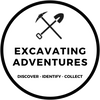In this quick and inexpensive tutorial, we are going to show you how to make a DIY Fossil Bed Excavation for the young Excavating Adventurer in your life to dig into and enjoy.
Excavating Adventure Pro Tip: This DIY Fossil Bed Excavation is a great activity to include in any discussions or lessons regarding dinosaurs, fossils, paleontology, and more. Be sure to explore our blog for dozens of DIY Fossil Excavation activities.
Materials:
Sand
Plaster of Paris
Water
Mixing Bowl
Wooden spoon
Measuring cups
Popsicle stick, wooden dowels, brushes, magnifying glass, and safety goggles. These will be the excavation tools and safety equipment your Excavating Adventurer will need to explore and enjoy their excavation.
Assorted bag of mixed fossils. These can be purchased online. You can also use fun little plastic dinosaurs.
Aluminum pie pan. You can also use the lid from Styrofoam take out containers or a paper plate with deep sides. The idea is to have a reasonably shallow container that is about 12 inches in size.
If you love digging for real fossils, be sure to check out excavation kit loaded with real fossils! We also have fossil kits for classrooms and birthday parties so you can bring an exciting fossil bed excavation activity to your next lesson or birthday celebration.
Directions:
- Spread the fossils out in the bottom of the aluminum pie pan.
- Mix 3 cups sand with 1 cup Plaster of Paris.
- Add 1 cup of water and mix until you have a pancake batter consistency.
- Pour the mixture over the fossils in the pan.
- Gently tap the sides on the pie pan to settle and level out the mixture.
- Optional – Once the mixture begins to set and firm up (usually after 8-10 minutes), place little plastic dinosaurs on the surface of the excavation.
- Place the excavation in front of a fan overnight until it dries completely.
- Once the excavation is dry, distribute the excavation tools and safety goggles and let your Excavating Adventure dig in and discover the treasures you have hidden inside.
Excavating Adventures Pro Tip: Get online and look for an area near you to take your young Excavating Adventurer on a fossil hunt. You may be surprised to find an area close by that is accessible and available to search for fossils. Just be sure to follow any rules and regulations and have fun being a Junior Paleontologist for the day!
Time Capsules of the Past: Fun Facts about Fossil Beds!
Fun Facts about Fossil Beds:
-
Fossil beds are places where a large number of fossils are found together, providing valuable insights into ancient life forms and ecosystems.
-
Fossil beds can be found in various locations, including deserts, riverbanks, quarries, and even beneath the ocean floor.
-
The fossils found in beds can range from tiny microfossils to large skeletons of dinosaurs and other prehistoric creatures.
-
Fossil beds often form in areas where sediments accumulate over time, such as ancient lakes, swamps, or areas affected by volcanic eruptions.
-
The fossils in beds can include the remains of plants, animals, shells, bones, and even footprints, offering a diverse glimpse into the past.
-
Scientists study fossil beds to learn about Earth's history, including the evolution of species, changes in climate, and the movement of continents.
-
Fossil beds can preserve delicate details of ancient organisms, providing clues about their anatomy, behavior, and interactions with the environment.
-
Paleontologists carefully excavate and study fossil beds to understand the relationships between different species and the processes that shaped life on Earth.
-
Fossil beds can yield surprising discoveries, such as the famous Burgess Shale in Canada, which revealed a diverse range of ancient marine life.
-
Visiting a fossil bed can be an exciting adventure, as you can search for fossils, join guided tours, or explore interactive exhibits in museums.
-
Fossil beds are like time capsules, helping us piece together the story of life on Earth and the incredible diversity of organisms that have existed.
-
By studying fossils from different beds around the world, scientists can unravel mysteries of the past and deepen our understanding of the natural world.
So, put on your paleontologist hat and get ready to explore the ancient wonders hidden within fossil beds!
Be sure to check out our inexpensive and exciting monthly excavation subscription!
Question 1: Where are fossil beds commonly found? A) City centers B) Mountain peaks C) Deserts D) Underwater caves
Correct answer: C) Deserts
Question 2: What can be preserved in fossil beds? A) Ancient artifacts B) Modern technology C) Fossils of plants and animals D) Human remains
Correct answer: C) Fossils of plants and animals
Question 3: Why do scientists study fossil beds? A) To predict future weather patterns B) To uncover hidden treasure C) To learn about the past life on Earth D) To develop new technologies
Correct answer: C) To learn about the past life on Earth

